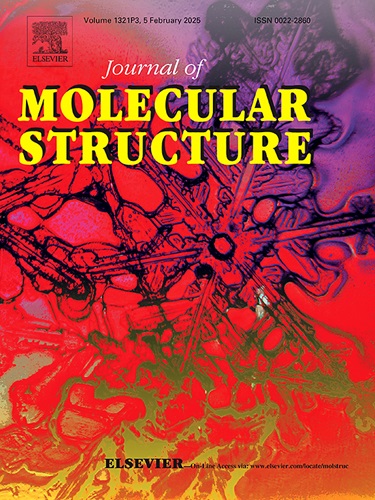Synergistic structural-electronic strategy enhances magnetic relaxation in DyIII single-molecule magnets
IF 4.7
2区 化学
Q2 CHEMISTRY, PHYSICAL
引用次数: 0
Abstract
Three new binuclear dysprosium complexes bridged by 4‑hydroxy-3,5-dimethoxybenzaldehyde (DMOAP), 2,6-dimethoxyphenol (DMOP), and 2,6-dimethoxy-4-methylphenol (DMOMP), formulated as [Dy2(NO3)4(DMOAP)2(SCN)2]·2(Et)3NH (1), [Dy2(NO3)4(DMOP)2(SCN)2]·2(Et)3NH (2) and [Dy2(NO3)4(DMOMP)2(SCN)2]·2(Et)3NH (3) were structurally and magnetically characterized. By varying the substituents on the DMOP bridge (electron-withdrawing and donating groups), we achieved fine-tuning of the Dy-Dy distances and the modulation to the Dy-Dy magnetic interactions, which ultimately resulting in enhanced single-molecule magnetic (SMM) properties. Dynamic magnetic measurement revealed that complexes 1–3 all exhibit characteristic single-molecule magnet behavior with effective energy barriers of 54.62 K, 105.46 K, and 129.96 K, respectively. Notably, complex 3 bridged by methyl-substituted DMOP exhibits magnetic hysteresis up to 4 K and a clear open hysteresis loop with a coercive field of 221 Oe is observed under zero applied DC field at 1.9 K, which is rarely observed in non-radical-bridged binuclear lanthanide SMMs.

协同结构-电子策略增强DyIII单分子磁体的磁弛豫
以4-羟基-3,5-二甲氧基苯甲醛(DMOAP)、2,6-二甲氧基苯酚(DMOP)和2,6-二甲氧基-4-甲基苯酚(DMOMP)为桥接物,合成了[Dy2(NO3)4(DMOAP)2(SCN)2]·2(Et)3NH(1)、[Dy2(NO3)4(DMOP)2(SCN)2]·2(Et)3NH(2))和[Dy2(NO3)4(DMOMP)2(SCN)2]·2(Et)3NH(3))三种新型双核镝配合物。通过改变DMOP桥上的取代基(吸电子基和供电子基),我们实现了Dy-Dy距离的微调和Dy-Dy磁相互作用的调制,最终导致单分子磁性(SMM)性能的增强。动态磁性测量表明,配合物1-3均表现出典型的单分子磁性行为,有效能垒分别为54.62 K、105.46 K和129.96 K。值得注意的是,甲基取代DMOP桥接的配合物3表现出高达4 K的磁滞,并且在1.9 K的零直流场下观察到一个清晰的开放磁滞环,其顽固性场为221 Oe,这在非自由基桥接的双核镧系smm中很少观察到。
本文章由计算机程序翻译,如有差异,请以英文原文为准。
求助全文
约1分钟内获得全文
求助全文
来源期刊

Journal of Molecular Structure
化学-物理化学
CiteScore
7.10
自引率
15.80%
发文量
2384
审稿时长
45 days
期刊介绍:
The Journal of Molecular Structure is dedicated to the publication of full-length articles and review papers, providing important new structural information on all types of chemical species including:
• Stable and unstable molecules in all types of environments (vapour, molecular beam, liquid, solution, liquid crystal, solid state, matrix-isolated, surface-absorbed etc.)
• Chemical intermediates
• Molecules in excited states
• Biological molecules
• Polymers.
The methods used may include any combination of spectroscopic and non-spectroscopic techniques, for example:
• Infrared spectroscopy (mid, far, near)
• Raman spectroscopy and non-linear Raman methods (CARS, etc.)
• Electronic absorption spectroscopy
• Optical rotatory dispersion and circular dichroism
• Fluorescence and phosphorescence techniques
• Electron spectroscopies (PES, XPS), EXAFS, etc.
• Microwave spectroscopy
• Electron diffraction
• NMR and ESR spectroscopies
• Mössbauer spectroscopy
• X-ray crystallography
• Charge Density Analyses
• Computational Studies (supplementing experimental methods)
We encourage publications combining theoretical and experimental approaches. The structural insights gained by the studies should be correlated with the properties, activity and/ or reactivity of the molecule under investigation and the relevance of this molecule and its implications should be discussed.
 求助内容:
求助内容: 应助结果提醒方式:
应助结果提醒方式:


